In the world of metallurgy, aluminum and its alloys stand out for their exceptional qualities—lightweight, corrosion resistance, ductility, high strength-to-weight ratio, conductivity, reflectivity, recyclability, machinability, and versatility. These make them prized materials in aerospace, automobile, electricity, chemistry, transportation, national defense, and various other industries.
I. What is Aluminum and its Alloy Welding?
Aluminum welding involves the fusion of two or more aluminum pieces using heat and filler material. Aluminum alloys, formed by incorporating metals like copper, zinc, or magnesium into pure aluminum, require additional expertise for robust and durable welding.
Mastering this intricate craft requires not only technical know-how but also a deep understanding of the properties and behavior of aluminum and its alloys during the welding process. Let's delve further into the nuances of aluminum welding process, exploring its complexities and the artistry required to create impeccable welds.
II. Benefits of Aluminum and Its Alloy Welding.
Due to the features of aluminum and its alloy, aluminum and aluminum alloy welding has a variety of advantages, that is:
Lightweight: Lightweight aluminum and its alloys welding can create lightweight structures that are strong and durable, making them popular welding material choices in industries such as aerospace, automotive, and construction.
High Strength: A high strength-to-weight ratio makes them ideal for applications where weight is a critical factor, such as aircraft and automotive components.
Corrosion Resistance: Excellent corrosion resistance makes them suitable for use in harsh welding environments where other metals may corrode.
High Thermal Conductivity: High thermal conductivity makes it an excellent choice for applications where heat transfer is important, such as in the construction of heat exchangers and radiators.
Versatility: Aluminum and its alloys can be easily welded using various welding processes such as TIG, MIG, and Stick welding, so they can be used in a wide range of applications.
Cost-Effective: Aluminum and its alloys are cost-effective compared to other materials such as titanium, making them a popular choice in many industries.
III. Difficulties of Aluminum and Its Alloy Welding.
Oxidation: Aluminum quickly forms an oxide layer when exposed to air, which can make it difficult to create a strong weld. To prevent oxidation, welders must use specialized techniques, such as cleaning the metal surface and using a shielding gas.
Heat Dissipation: Aluminum has a high thermal conductivity, which means that it quickly dissipates heat. This can make it difficult to maintain a consistent temperature during the welding process, which is essential for creating a strong weld.
Softness: Aluminum and its alloys are soft metals that can be easily deformed. This can make it challenging to maintain the proper shape and alignment during the welding process.
Cracking: Aluminum and aluminum alloys are prone to cracking during the welding process, especially if the welder does not use the proper techniques and equipment. Cracking can weaken the weld and compromise its integrity.
Filler Material: The filler material used for aluminum and aluminum alloy welding must match the composition of the base metal to ensure a strong and durable weld. Using the wrong filler material can result in a weak and brittle weld.
IV. Aluminum and Its Alloy Welding Techniques.
Tungsten Inert Gas (TIG/GTAW) Welding Aluminum: TIG welding is a popular technique used to weld aluminum and its alloys. It uses a non-consumable tungsten electrode to produce an arc, and a filler metal is added to the weld pool manually. TIG/GTAW welding aluminum is a precise and clean welding technique that produces high-quality welds.
Metal Inert Gas (MIG/GMAW) Welding Aluminum: MIG welding is a semi-automatic welding technique that uses a wire feed to supply the filler metal to the weld pool. It uses a shielding gas to protect the weld pool from atmospheric contamination. MIG/GMAW welding aluminum is faster than TIG welding aluminum and is suitable for welding thicker aluminum materials.
Stick Arc Welding (MMA Welding) Aluminum: Stick welding, also known as Shielded Metal Arc Welding (SMAW), is a manual welding technique that uses a consumable electrode coated in flux. Stick arc welding aluminum is suitable for welding aluminum in areas where access is limited.
Friction Stir Welding Aluminum: Friction Stir Welding (FSW) is a solid-state welding technique that uses a rotating tool to generate heat and plasticize the aluminum material. The tool then moves along the joint, mixing the material to create a strong bond. FSW welding aluminum is suitable for welding aluminum alloys that are difficult to weld using traditional welding techniques.
V. Aluminum and Its Alloy Welding Equipment.
1) Welding Machine: A welding machine is a device that produces the heat needed to melt and fuse the aluminum material. The type of welding machine used depends on the welding technique used. TIG welding machines are different from MIG welding machines, and each has its unique features. Megmeet is one of the best welding machine designers and manufacturers in China and has developed and produced several series of intelligent and digital-control CO2/MIG/MAG/TIG welding machines based on high-frequency control of the power source. You can contact Megmeet to consult the welding machine price and buy the ideal welding power sources.

2) Welding Torch or Gun: The welding torch or gun is the component that holds the electrode or wire and delivers the heat to the aluminum material. The type of torch or gun used depends on the welding technique used.
3) Filler Material: Filler material is required to fill the gaps between the two pieces of aluminum material being welded. The type of filler material used depends on the welding technique used and the aluminum alloy being welded.
4) Gas Cylinder: A gas cylinder is used to supply the shielding gas required to protect the weld pool from atmospheric contamination. The type of gas used depends on the welding technique used.
5) Electrodes: TIG welding requires a non-consumable tungsten electrode, while MIG welding requires a consumable wire electrode. The type of electrode used depends on the welding technique and the aluminum alloy being welded.
6) Wire Feeders: MIG welding requires a wire feeder that feeds the wire electrode into the welding torch at a specific rate.
7) Welding Helmet: A welding helmet is worn by the welder to protect the eyes and face from the bright light produced during welding.
Aluminum and aluminum alloy welding is a specialized skill that requires knowledge of specific techniques and equipment. It offers several benefits, including its lightweight, corrosion-resistant properties, high strength-to-weight ratio, and good thermal conductivity. There are several techniques and specialized equipment used in aluminum and aluminum alloy welding, including TIG welding, MIG welding, and Stick welding. If you're looking to perform aluminum or aluminum alloy welding, be sure to choose the right technique and equipment for the job to ensure a strong and durable weld.
If you want to learn more welding tips, you can collect Megmeet News Center Page or follow our LinkedIn page.
FAQs of Aluminum and Its Alloy Welding
1. Can aluminum welding be done without specialized equipment?
2. Which welding technique is best for thin aluminum materials?
3. Why is oxidation a challenge in aluminum welding?
4. What role does filler material play in aluminum welding?
5. Why is a welding helmet essential in aluminum welding?
Related articles:
1. Aluminum Welding Techniques and Methods
2. AC TIG Welders for Aluminum Welding
3. Welding Aluminum vs. Welding Steel: A Complete Comparison
4. Welding Aluminum vs. Welding Steel: Key Differences
5. MIG and TIG Guidelines for Aluminum Welding




